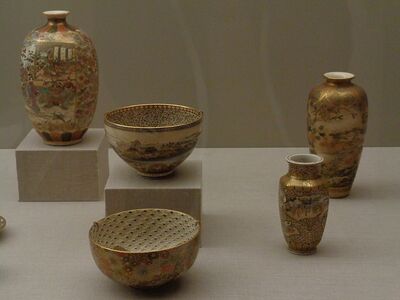
A set of small Meiji period Satsuma ware pieces.
- Japanese: 薩摩焼 (Satsuma yaki)
Satsuma wares refers to two unrelated types of pottery. Early Satsuma wares, produced up through the 18th century chiefly for use in tea ceremony, were simple, cream-colored ceramics with a pale, finely-crackled yellow glaze. Beginning in the Meiji period, however, the term came to refer to a style of works lavishly decorated in gold and polychrome overglazes, with exceptionally detailed multi-color images of figures or scenes. While the earlier type were chiefly produced in Satsuma province, the latter type are produced in Kyoto, Osaka, and elsewhere, in addition to being produced in Satsuma.
References
- Gallery labels, Santa Barbara Museum of Art.